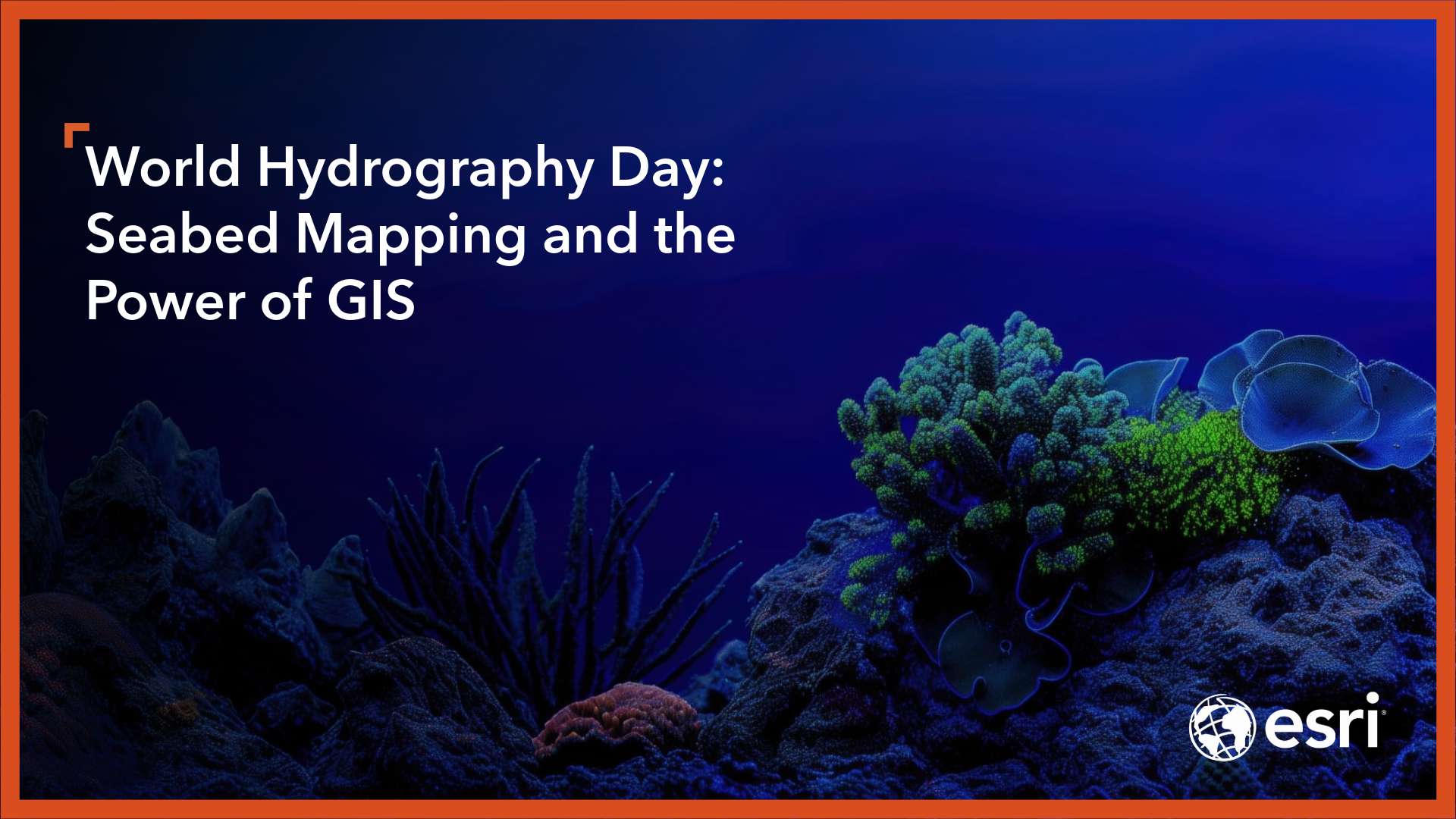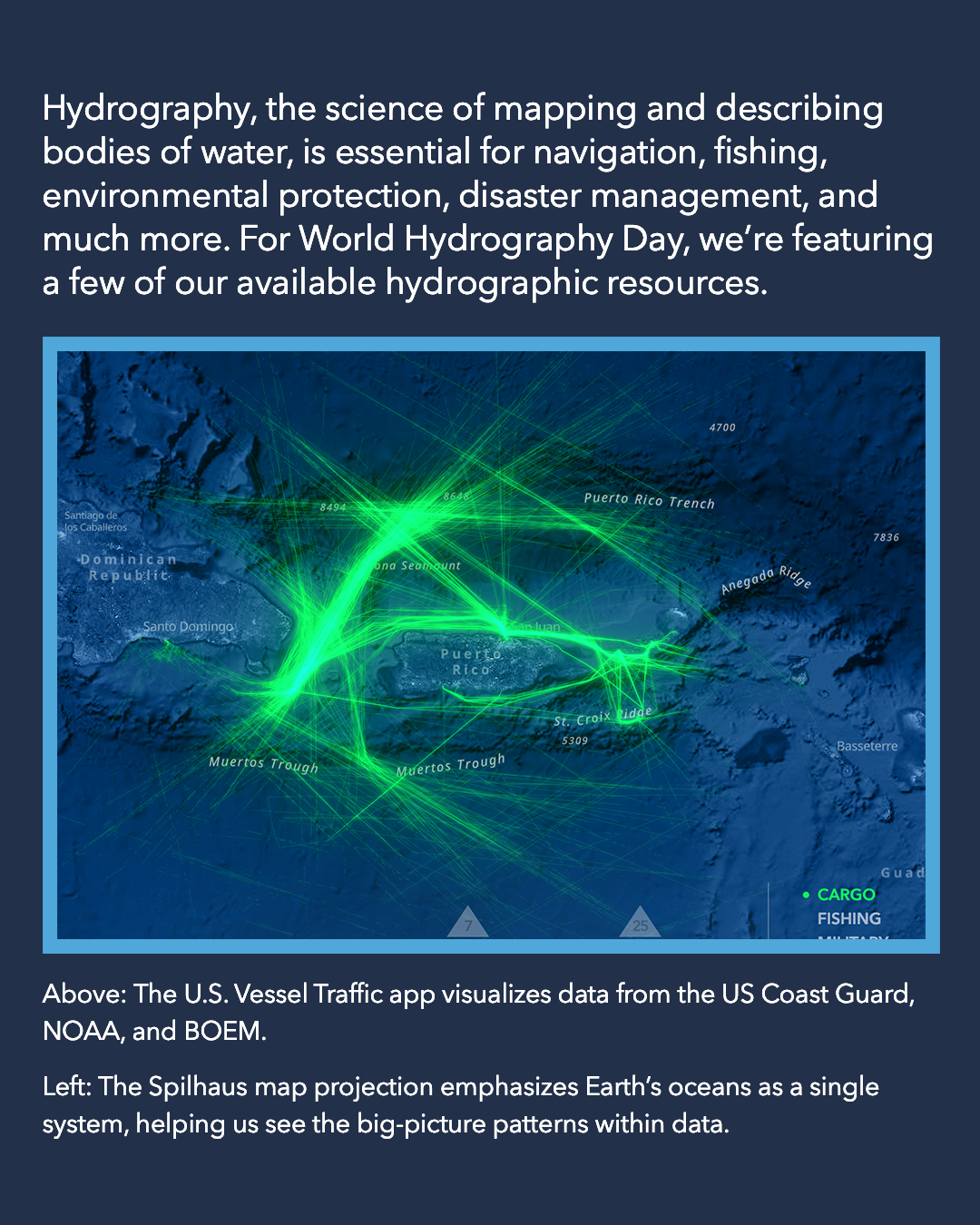
Seabed Mapping: Enabling Ocean Action
Every year on June 21, the global hydrographic community gathers to celebrate World Hydrography Day, a moment to highlight the essential role of hydrography in understanding and managing our oceans. This year’s theme, “Seabed Mapping: Enabling Ocean Action,” highlights the importance of accurate seabed mapping for navigation, environmental protection, economic development, and scientific research. In this blog, let’s explore how Esri’s extensions support this global effort by advancing seabed mapping, enabling smarter decision-making, and helping organizations turn data into meaningful ocean action.
S-100 Standards and Esri’s support
Geographic Information Systems (GIS) play an important role in modern hydrography, especially as the industry embraces the IHO S-100 framework—a next-generation standard for organizing and sharing hydrographic data. S-100 supports a wide range of digital products, including electronic navigational charts (S-101 ENCs), bathymetric surfaces (S-102), and marine safety information. Designed for real-time updates and high-resolution data, it enables seamless integration with geospatial systems, making it a cornerstone of Marine Spatial Data Infrastructures (MSDIs).
These infrastructures help governments, researchers, and industry partners bring together diverse datasets—such as tides, seabed depth, and marine protected areas into a consistent, interoperable environment. The full value and capability of S-100 can only be achieved with GIS applications like ArcGIS that can enhance situational awareness, improve data accessibility, and support more informed decision-making. This harmonization not only promotes collaboration across agencies and sectors but also strengthens sustainable ocean governance, advancing the hydrographic mission on a global scale.

Esri’s Role in Hydrography
Esri is a key supporter of the global hydrographic community, providing tools that enhance marine and coastal mapping. Our technology empowers hydrographic offices, port authorities, navies, and maritime enforcement agencies—including coast guards and harbor patrols—with solutions that support a wide range of applications, from safe navigation and port operations to subsea cabling, offshore energy planning, and environmental monitoring. All of this is made possible through the geographic approach, which uses the power of location to integrate data, reveal patterns, and guide informed decision-making.
ArcGIS for Hydrography: Bathymetry and Maritime Extensions
Organizations frequently manage large, overlapping bathymetric datasets in non-spatial, file-based systems, which can make analysis and data sharing challenging. ArcGIS Bathymetry simplifies the management, analysis, and sharing of bathymetric data, enabling organizations to make better decisions more quickly. It extends ArcGIS Pro with specialized tools and workflows for exploring and modeling bathymetric data and its metadata within a GIS environment.
ArcGIS Maritime enables the production of nautical products that meet international standards. By leveraging the geographic approach, it automates production tasks, ensuring the high quality of information products. In addition to modernizing the production of ENCs, this technology also allows for the generation of paper charts directly from ENC, streamlining the charting process and maintaining up-to-date information. Beyond charting, ArcGIS Maritime supports a variety of marine applications, including shore-based mission planning and situational awareness. The advancements in Esri technology have expanded its capabilities, making it an indispensable tool for a wide range of maritime activities.
Real-World Applications of ArcGIS
In industries like oil and gas, ports and navigation, and telecommunications, bathymetric data is foundational to safe and efficient operations. It helps identify optimal drilling locations while avoiding underwater hazards, guides dredging activities to maintain navigable waterways, and supports the precise planning of subsea cable routes that are economically feasible while minimizing environmental impact. ArcGIS Bathymetry streamlines these workflows by simplifying the management, analysis, and sharing of bathymetric data—empowering organizations across these sectors to make faster, more informed decisions.
These capabilities aren’t just theoretical—they’re already transforming operations across industries. Ørsted, a global leader in renewable energy, uses the ArcGIS Maritime Chart Server extension to enhance the safety and efficiency of its offshore wind farm operations. This extension provides access to real-time nautical charts and navigational data, which are essential for safe vessel movement around wind installations. Integrated with their GIS systems, the extension supports resource management by enabling route planning and operational optimization based on authoritative chart data. It also ensures compliance with maritime regulations, reinforcing Ørsted’s commitment to safety and accountability. In emergency scenarios, the extension delivers real-time information that supports swift, informed decision-making.
These are just a few examples highlighting how ArcGIS enables organizations across industries—from traditional sectors like oil and gas to renewable energy leaders like Ørsted—to make smarter, safer, and more sustainable decisions using the power of ArcGIS.

Explore Resources for World Hydrography Day
In celebration of World Hydrography Day and the power of GIS, explore these featured resources:
- Spilhaus Storymap: A story about the “Spilhaus projection” – a map projection that focuses on the one world ocean that went viral in fall 2018 and is now supported in ArcGIS.
- Titanic: The story behind the passengers of the Titanic, one of the first “viral” ArcGIS Storymaps
- Restoring Our Oceans: Dive into 50 inspiring stories about ocean exploration, marine wildlife and habitat, innovative tech for mapping ocean data, and more.
- Marie Tharp & Heinrich Berann: Make a seafloor map in the spirit of Marie Tharp & Heinrich Berann
- What’s New in ArcGIS Bathymetry: Explore new features and functionality in the latest release of ArcGIS Bathymetry
- What’s New in ArcGIS Maritime: Explore new features and functionality in the latest release of ArcGIS Maritime

Article Discussion: